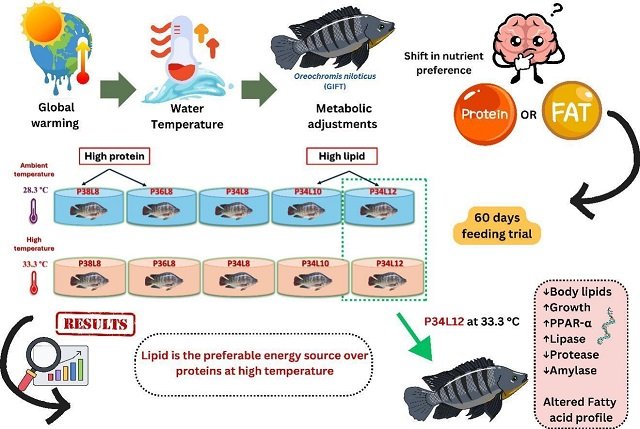
Global warming poses a significant threat to aquaculture, particularly for open water systems where rising water temperatures can negatively impact fish health and productivity. For tropical species like GIFT tilapia, which are already operating near their thermal tolerance limits, even a slight increase in temperature can have detrimental effects.
A recent study published in the journal Comparative Biochemistry and Physiology Part B: Biochemistry and Molecular Biology by scientists from ICAR-Central Institute of Fisheries Education and ICAR-Central Institute of Freshwater Aquaculture investigated the dietary preference of genetically improved farmed tilapia (GIFT) raised at high temperatures. The research focused on whether protein (P) or lipids (L) in the diet served as a more efficient energy source under these conditions.
Nutritional intervention as a potential solution
Previous studies have demonstrated the potential of nutritional interventions to mitigate the adverse effects of thermal stress in fish. By carefully adjusting the diet composition, it may be possible to improve species fitness and enhance growth rates at elevated temperatures. However, most research to date has focused on the role of micronutrients and additives, leaving largely unexplored the metabolic impacts of major macronutrients such as proteins, carbohydrates, and lipids.
The challenge: feeding GIFT tilapia in warm water
As water temperatures increase due to climate change, maintaining optimal growth and health in GIFT tilapia becomes an urgent concern. This study investigated whether protein (P) or lipids (L) in the diet play a more crucial role as an energy source for GIFT tilapia raised in warm water.
The role of proteins and lipids
This study aimed to investigate the metabolic effects of dietary proteins and lipids on GIFT tilapia raised at high temperatures. The research focused on the following key areas:
- Protein requirements in the diet: The optimal level of essential amino acids for maximum growth may vary with rearing temperature. Excessive protein intake can lead to increased ammonia excretion and reduced growth.
- Heat increment: High-protein diets may contribute to greater heat production (specific dynamic action or SDA), which can be particularly detrimental at high temperatures.
- Benefits of lipids: Lipids, being the macronutrients with the highest energy density, offer a potential advantage in meeting the increased energy demands of fish at higher temperatures. They are also highly sensitive to dietary and environmental factors, making them a promising energy source.
- Membrane fluidity: Lipids play a crucial role in maintaining membrane fluidity, which is essential for optimal cellular function under fluctuating temperature conditions.
The experiment: testing different diets
The researchers conducted a 60-day feeding trial with GIFT tilapia maintained at two temperatures: 28.3°C (control) and 33.3°C (elevated). Five different diets were tested, each with varying levels of protein (34%, 36%, or 38%) and lipids (8%, 10%, or 12%). These diets were identified as PXXLYY, where XX represents the protein level and YY represents the lipid level (e.g., P34L12 has 34% protein and 12% lipids).
Key findings
The study revealed several key findings:
Stay Always Informed
Join our communities to instantly receive the most important news, reports, and analysis from the aquaculture industry.
- Fish fed the diet with optimal protein (34%) and the highest lipid level (12% – P34L12) showed significantly greater weight gain and thermal growth coefficient.
- Interestingly, increasing the lipid content in the diet reduced overall body fat deposition in the fish. At higher temperatures, diets with higher lipid content seemed to mobilize serum triglycerides and cholesterol, suggesting a more efficient use of energy.
- Changes in rearing temperature and diet composition significantly affected the fish’s fatty acid profile. Unsaturated fats were favored for energy production (β-oxidation). Notably, the P34L12 group maintained healthy levels of essential fatty acids like EPA, DHA, and linolenic acid, particularly at high temperatures.
- The study observed positive regulation of PPAR-α, a marker of fat breakdown, with increased temperature and high lipid intake. This suggests a metabolic shift toward utilizing fat for energy, especially in the P34L12 group.
Implications for aquaculture
These findings suggest that high-lipid diets (12%) offer a significant advantage over high-protein diets for GIFT tilapia raised at elevated temperatures. This approach can:
- Optimize growth: Fish fed P34L12 diets achieved superior weight gain.
- Improve metabolic efficiency: Lipid-rich diets seem to promote better utilization of energy reserves and reduce fat deposition.
- Maintain essential fatty acid profile: The P34L12 group preserved beneficial fatty acid levels even under thermal stress.
Conclusion
This study provides valuable insights for optimizing GIFT tilapia aquaculture practices at elevated temperatures. High-lipid diets (12%) appear to be superior to high-protein diets in promoting growth, improving metabolic efficiency, and maintaining a healthy fatty acid profile for consumers. Implementing these findings can contribute to a more sustainable and high-quality tilapia production system.
Contact
Tincy Varghese
Fish Nutrition, Biochemistry and Physiology Division, ICAR-Central Institute of Fisheries Education
Mumbai, India.
Email: tincy@cife.edu.in
Reference (open access)
Akhila, S., Varghese, T., Sahu, N. P., Gupta, S., Dasgupta, S., Deo, A. D., Mannur, V. S., Paul Nathaniel, T., & Chandan, N. K. (2024). Hyperthermal stress potentiates enhanced lipid utilisation in genetically improved farmed Tilapia, Oreochromis niloticus juveniles. Comparative Biochemistry and Physiology Part B: Biochemistry and Molecular Biology, 111033. https://doi.org/10.1016/j.cbpb.2024.111033
Editor at the digital magazine AquaHoy. He holds a degree in Aquaculture Biology from the National University of Santa (UNS) and a Master’s degree in Science and Innovation Management from the Polytechnic University of Valencia, with postgraduate diplomas in Business Innovation and Innovation Management. He possesses extensive experience in the aquaculture and fisheries sector, having led the Fisheries Innovation Unit of the National Program for Innovation in Fisheries and Aquaculture (PNIPA). He has served as a senior consultant in technology watch, an innovation project formulator and advisor, and a lecturer at UNS. He is a member of the Peruvian College of Biologists and was recognized by the World Aquaculture Society (WAS) in 2016 for his contribution to aquaculture.




